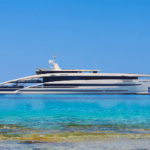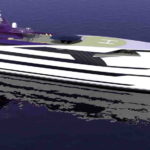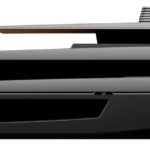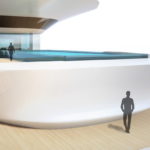Movements in the superyacht industry are rife, true innovations less so, while the market is changing faster than the industry realizes, reports Nick Jeffery
New order book reports and global wealth surveys suggest the market should be growing faster than it is, as more[ds_preview] billionaires are created year on year. A decade on from the »end of an era« (when Liveras Yachts’ serial yacht owner and entrepreneur Andreas Liveras was killed in Mumbai and the market crashed in 2008) »yachting remains the unique pastime, available only to the happy few who have the wherewithal to discover it – the markets are stable but slow«, according to Lürssen’s Sales Director Michael Breman. Benetti’s CEO, Vincenzo Poerio, believes that »there are some good signs coming from the market, mostly for large yachts whose demands are following a clear trend: large size, high quality interiors, less ostentation and finishing for the exteriors and structures.« He adds: »We have to remember that the (new build) market is influenced by used boats that offer to owners shorter delivery times – one reason why shipyards are equipping and organizing themselves to guarantee extensive customisation with reduced delivery times.« Heesen has a full order book to 2022 and feels »the market is back to pre-credit crunch levels«.
On the sailing boat front, Baltic Yachts’ Sales Director, Marcus Jungell, feels »the market is slightly more active compared to last year. The main competition to the new build superyacht segments is the second-hand superyacht market and charter yachts«. Naval architect Hugh Welbourn echoes the upbeat feeling: »We are seeing a sense of excitement around that has been missing for a long time – again this is reflection of a changing attitude to disruptive technologies with the more technically aware potential clientele.« Wally’s Luca Bassani also sees the market being »more lively with increasing demand« but notes competition from »adventure and exploration travels« as well as »staying in high end resorts«. Bassani adds: »Whatever the innovations and trends are, it is important that we manage to attract and engage the so-called millennials and generation Z, because the big challenge the industry is facing is to find new generation owners, as the traditional owners are aging and, so far, there is no replacement. Most of the young potential prospects seem to prefer to charter yachts and experience the superyacht ›lifestyle‹, while the passion for the sea and sailing skills is unfortunately missing.«
Burgess CEO Jonathan Beckett says: »The market has held up really quite well over the past twelve months. We have seen a quietening of the Russian market and a swift gathering of pace in the American market (historically superyachting’s biggest market place). China and Asia are coming too, but at a different pace. The main competition to superyacht ownership and superyacht chartering is, I suppose, property ownership and/or business opportunities swallowing up the extra available cash.« As Beckett is a senior industry figure, it is natural that he is looking to the next generation: »The biggest movement in the industry as a whole right now is the ›handing down‹ of the management, roles and responsibilities from the senior company owners and senior company managers to the next generation. In ten years time the landscape and the players will be different. That is exciting!«
International Superyacht Society (ISS) President AJ Anderson notes the market challenge: »The principal competition to the drive for more yacht owners and charter clients is that potential customers are unaware of the possibility, or if they are aware of the possibility, they are uncertain as to how easy both can be. Lifestyle media and well-funded brokerages are doing an excellent job bringing the message to potential customers who have no knowledge of the yacht industry.«
Superyacht broker Peter Insull, recipient of the Richard Earp Award 2018 (recognizing ethical behaviour and charm, among other attributes) notes: »The market in second hand motoryachts has a reasonable amount of activity right now. For quality motoryachts there is an actual ›shortage‹ in the market place today. If you are looking to acquire a motoryacht in the 90m range the availability has been reduced with few ›interesting options‹.« Two online charter services launched in 2018 but they have had little success penetrating the large yacht market. Insull comments: »The charter side of yachting is under the scrutiny of new companies who view the present style of commercialisation as old style, even out of touch. I do not think that in the mid- to long-term the new, very aggressive style of charter brokerage companies will succeed, but we will see some collateral damage.« Insull is outspoken about the new build market: »While the industry’s pedigree shipyards appear, through their cloak of secrecy, reasonably busy with new construction orders the number of very large yacht orders appear to be reduced. Geo-political impact has always been an issue with the yachting sector, often in a positive fashion and sometimes in equal amounts in a negative fashion. The USA client base is very active for new yachts whilst what was a high percentage from Russia appears to be very slow.«
Design and sustainability merge
MCM’s Peter Wilson believes the future is positive, expecting within five years: »innovative design that is unconstrained by yachting convention, efficient building processes, fascinating superyacht destinations, more transparency for owners, a wider choice of high-end marinas and resorts – and a united mission to actively protect and contribute towards cleaner oceans.« He adds: »Simultaneous with advances in construction, efficiency, communications, security and lower emissions, the whole superyacht lifestyle will be about sharing adventures with family and friends with the focus being on health/wellbeing of those on board and the environment in which they cruise.«
Undoubtedly, the sustainability talk has made everybody in the industry environment »aware«. Fondation Prince Albert II has been a leader in protecting the environment and tapped into the superyacht world, initially through its »Wood Forever« Pact, targeting designers, now through its Monte Carlo Gala, hosted on 26 September 2018 during Monaco Yacht Show, raising vast sums at auction. Marine Protected Areas (MPAs) have proven to be an effective tool to resist the growing threats to the marine environment and afford marine ecosystems greater resilience to the impacts of climate change. Healthier oceans provide greater adaptive capacity to climate change for both ecosystems and the people that depend upon them. In addition, MPAs covering habitats like mangroves, seagrass beds and salt marshes can mitigate climate change by sequestering carbon. While recent MPA growth has been impressive, it is insufficient both with regard to numbers and size to ensure effective conservation of ocean biodiversity and ecosystem services. Recent discussions focused on how to make MPAs more effective by making them bigger and better connected, and to do so more quickly.
Edited extracts from AJ Anderson’s ISS executive letter note: »While our industry is achieving excellence at a number of levels there are areas that require improvement – opportunities to contribute in a higher way to our world’s sustainability. That means people and the environment. In the last twenty years, charitable investment in time, human resources and cash has grown substantially across all yacht industry sectors and by individual industry professionals. The last five years shows a near vertical curve.«
Peter Insull gives a broker’s view: »There is always more talk than action on the environmental question. The issue of plastic in the oceans certainly gets a lot of press and I think we could see an increased level of actual action from the yachting sector. This would be excellent.«
Winch Design has noted: »an increase in the use of sustainable fabrics and materials, we incorporate these into our projects where possible. Some clients are very aware of sustainability and it is becoming increasingly important in our design process as we are trying to avoid using restricted or endangered woods and materials.« The company adds: »Movements are difficult to interpret but what we can say is that clients are living on board far more, some clients are spending the entire season on their yachts, making it their primary residence. This changes how we design. Clients are gearing more towards functionalism and versatility. There has also been a significant increase in the number of younger clients and families; therefore yachts are becoming more child friendly, accommodating teaching staff and incorporating additional relaxation areas.«
CQStudio of Milan agrees: »There is an upgrowing awareness towards sustainability in design and in the industrial process which will hopefully lead to the output of more sustainable products and interiors.« Jonathan Beckett adds: »I believe more and more yachts are aiming to become more environmentally friendly in their operations, be it fuel burn, solar energy, recycling or plastic waste.«
Glass and Hybrid still are key words coming up when designers or builders are asked about design movements. Michael Breman says: »more and more glass in large surfaces is used, starting with the smaller production yachts and now finding its way in the larger bespoke yachts. Not new – see ›Rising Sun‹ for example – but a lot more frequent. In addition, there is a movement to have greener yachts, whatever that term may really mean! Hybrid power, zero emission mode, we are seeing it all but only a few things are sensible and feasible unfortunately!« Benetti’s Vincenzo Poerio: »The biggest movement in the industry at the moment is in terms of yacht size, which tends to keep growing. On top of that, in recent years, between many important innovations you can count the vertical bow, which as well as giving the yacht a different design, also changes the way it navigates and makes it possible to introduce different solutions inside the yacht. Another novelty is the use of glass, allowing the creation of designs and the management of natural light in truly innovative ways. In this regard, technology is giving a big boost to the application of this material in yachting«. Heesen too note glass as well as flat »domes« being two influences in overall look.
London-based Christian Leyk discusses forms: »I believe the biggest movement is the fact that 3D software as a design tool has finally matured to the extent that we now experience yacht exteriors designed (and ultimately built) to a level that was unimaginable until recently. Convex and concave surfaces and truly playful curves helped us to overcome the ubiquitous ›layer cake‹ yachts.«
Clifford Denn, whose Heesen projects received a standing ovation at its Monaco press conference last September, believes designers must: »Look at how to make one’s yacht greener, along with exploring alternative use of space on a yacht which is not necessarily the ›traditional‹ way. Younger clients are looking for a more radical /different ›think out of the box‹ approach on GA layouts and styling. We had a young client asking for drone landing pads.« Denn adds »I have seen hydrofoils on smaller boats – why not on a bigger yacht now? Smooth and fast and with present technology the foils could retractable so a ›normal‹ draft can be achieved (this was always a negative).«
Supersailers are speeding ahead on the innovation front. Bassani states: »beach clubs and large windows« as well as »foils to increase speed and reduce consumption«. Baltic’s Jungell: »We find longer autonomy driven by hybrid propulsion and regeneration of energy as one of the main movements in the yachting industry. This will enable us to build even lighter composite yachts in the future. We foresee even more emphasis on environmental aspects and more sustainable solutions for the yachts. An important innovation is the Dynamic Stablity Sytem (DSS) foil built in our new Baltic 142 Custom. The foil is moveable, built into her carbon composite hull. It is the first time this performance and comfort-enhancing feature has been designed into a superyacht.« MCM’s Peter Wilson expects to see more explorer style vessels pushing further afield with owners, their friends and charterers while »witnessing or participating in citizen science and ocean research.« He adds that supersailer regattas will continue to draw enthusiastic participants and »those newly minted sailors will discover the excitement of competing on the water. Through developments in hull shape, foils, sails, appendages and lightweight construction techniques, the performance curve will steepen ever-upwards.«
A whole new breed of motorsailers might arrive in the next decade – not your typical clunky image of a heavy boat with stumpy masts but sleek spaceship type vessels with reef-able wings, making »A« look conservative. Nigel Ingram of MCM, celebrating its 30th anniversary this year, believes: »it is only a matter of time« that foils will appear on supersailers, even though MCM’s most reecent launch is a Hoek classic 42m »Vijonara«. Naval architect Hugh Welbourn sees: »a new generation of clients that are seriously interested in adoption of new technologies. They come without the preconceived baggage of ›this is how it`s always been done‹ and are prepared to invest in the future for themselves« adding: »Personally of course, the understanding and beginnings of acceptance of how much benefit foils can add to the overall design package of almost all vessels is a challenging and exciting development. Also too, the growing adoption and maturity of electric and hybrid power systems is inevitably changing the ways that we designers can look at the overall package of any vessel. In both cases, this is a drive to the overall efficiency of the vessel, be it power or sail.«
Brands experience eco-quality
Even on the fitting out side, established specialist Glancy Fawcett notes eco-consciousness: »We have found the superyacht market is changing and so are the demographics of our clients; their age, culture and geographic location. With this shift, we’ve seen the definition of ›luxury‹ begin to change. Not all, but some clients are moving from picking brand-specific products to purchasing based on the quality of the products themselves, or how they are made if they are artisan products. Much like the experiential travel trend we are seeing; clients are buying for the experience they gain through the product. Clients are buying in a more eco-friendly and eco-conscious way. This is on all levels; the technology the yacht has itself, but also everything on board and how it’s cared for. We have found a move to focusing on where the products are sourced from and their sustainability. One example we’ve observed is removing plastic bottles and ensuring each cabin has a water jug and glass set on the bedside table and not a one-use bottle. We’ve received more questions on how to clean in an eco-friendly way, for the environment but also friendly to the products, meaning they have the durability they should have.«
Summing up the industry right now, Jonathan Beckett speaks from the edge: »The industry is in good shape and sensible place right now. Good for buyers and good for sellers. Good for owners and good for charterers. Long may this continue!«
Nick Jeffery





















